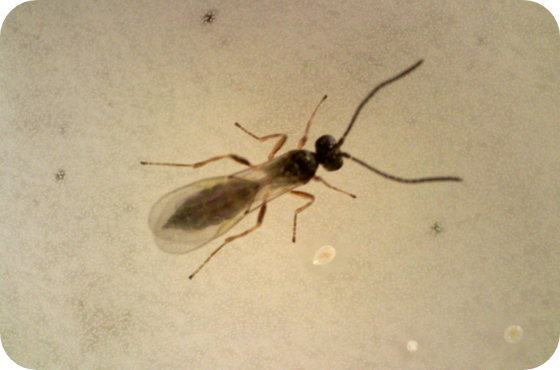Quality Products
Fast Delivery
Premium Service
Written by Kevin van Kester | Last update: 26. June 2023
The parasitic wasp Aphidius ervi is a powerful biological control agent against many species of aphids. Because of its superior ability to locate aphid hotspots, this natural enemy is highly effective in vegetable crops and ornamental cultivation.

The parasitic wasp Aphidius ervi measures about two millimetres in length. This size is relatively large for a natural predator, which is attributed to the larger pests it targets. The wasp can be recognized by its brown legs and its black, slender body with long antennae. Aphidius ervi typically lives for two to three weeks and can lay up to 350 eggs under ideal conditions.
Notably, ervi can be used both preventively and curatively in pest management.
Aphidius ervi excels in locating aphid colonies, making it can detect aphids from a long distance by scent. Once it identifies a colony, the female ervi uses her ovipositor to deposit an egg inside an aphid. During the initial days after the egg is laid, the aphid continues to feed on the plant and produces honeydew. As the egg hatches, the larva consumes the aphid from the inside, eventually mummifying it. The cycle completes when the new parasitic wasp emerges from the mummified aphid.
The parasitic wasp serves as an organic aphid control agent for various aphid species.
• Potato Aphid (Macrosiphum euphorbiae)
• Foxglove Aphid (Aulacorthum solani)
• Rose Aphid (Macrosiphum rosea)
You can determine if Aphidius ervi is doing its job well by looking for the following signs on your crops:
1. A golden-brown mummy on the leaf
2. A silk cocoon attached to the leaf
3. An empty cocoon with the ‘lid’ hanging from the leaf
Aphidius ervi is suitable for nearly all types of crops. This parasitic wasp operates most effectively at lower temperatures, and its activity declines considerably when temperatures rise above 30°C.
Aphidius ervi is supplied in bottles. Open the packaging only at the location where you will be applying the treatment. Distribute the mummies in a dry, shaded area or use the provided intro boxes. Avoid placing the mummies in damp locations, as moisture can lead to fungal issues.